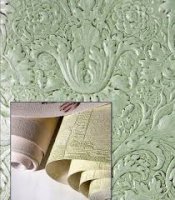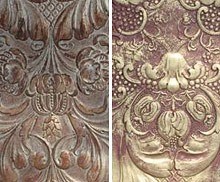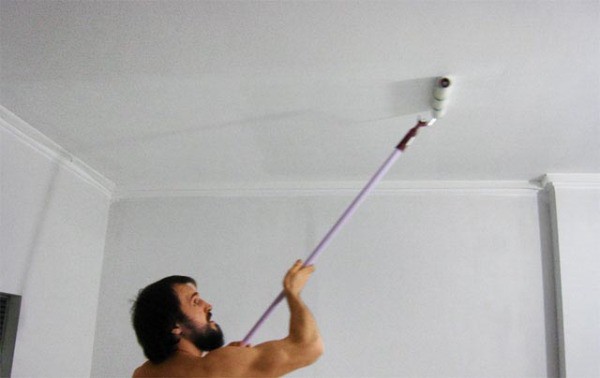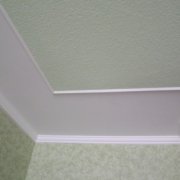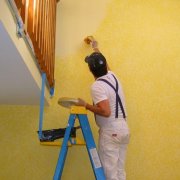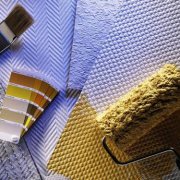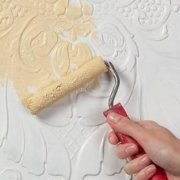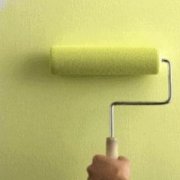How to paint the wallpaper on the ceiling according to the instructions
Wallpaper on the ceiling for painting should be chosen thoroughly. After all, their characteristics are quite different. But with their help, it is quite possible to make a smooth plane and after applying the dye everything will look even and monolithic.
How to choose and how to color the wallpaper on the ceiling, we will tell in this article. Also, you will be offered a video and photo where you can see the most difficult moments of application clearly.
The content of the article
What are the wallpaper for painting
When people plan to make repairs in their apartment, one of the important points of choice is the selection of finishing material. A huge number of options. However, as statistics show, most often their choice dwells on wallpaper cover.
Wallpaper for painting on the ceiling come with different characteristics, let's look at this issue in more detail:
- This is due, first of all, to the simplicity of gluing and the relative cheapness of the material. Yes, and to hire high-level specialists is not required. Everything can be done with your own hands, thereby reducing costs to a minimum. Even those who have not once glued wallpapers can cope with the task with dignity. The main thing is that the hands are in place.
- When choosing this type of finish, you need to remember that not all types are suitable for painting. Wallpaper for painting is made in accordance with the relevant requirements, characteristics.
| Paper wallpaper | In most cases, the paper surface also has a certain embossing relief, made using special technology.
|
| Non-woven wallpaper | Non-woven wallpaper (see Non-woven or vinyl wallpaper: choose which is better), as well as the above-described type of decoration, are characterized by embossment.
|
| Cullet | Wallpaper made of glass is distinguished by a pronounced texture that imitates a web, gunny or Christmas tree. The surface consists of fiberglass, which is intertwined with each other. Basically, cullets are used for partial decoration, very good for office and residential premises. |
| A bit about link crust | This type of wallpaper is made from natural materials. No synthetic innovations - the technological process has not changed since the 18th century. As it was, it remained unchanged.
|
How to prepare a concrete surface
The volume of work performed depends on what the walls are made of. If, for example, the entire surface is made of concrete, then the only thing that needs to be done is to plaster (see Wall plaster technology: how to do it right).
This is done in several stages:
- First, the wall is sprayed and a starting layer with a thickness of up to 6 mm is poured. Then apply the main finish layer of the same thickness (approximately)
- When the entire layer of plaster has dried, the entire surface is prepared and perfectly leveled using putty. It is applied in two layers.
- Each layer, without fail, is primed. The better the primer, the more durable the result. The final stage of all work is grouting the surface with a special abrasive mesh or sandpaper.
How to prepare a brick wall
To get started, you need to remove everything that remains of the old repair. This wallpaper is removed completely.
Attention: No need to experiment and glue directly on the old wallpaper. Any previous coating should be removed.
- Stock up on warm water and a metal spatula. When old wallpapers are saturated with moisture, they can easily be removed with a spatula. The hose is not useful for applying water, just a roller and a bath for painting. No need to flood the neighbors from below and also make repairs to them.
- If there were difficulties during the removal of the old finish, then the old grandfather method is suitable. Re-wet the wallpaper and go with a heated iron. Even the oldest Stalinist glue will not withstand heat treatment.
- If there is a water-based paint on the walls, then it can be easily washed off (see How to wash off the paint without problems) or apply a coat of primer and then, after drying, start gluing. A little more complicated if the walls and ceiling are painted with old oil paint. In this case, you need to carefully clean it with a spatula, or remove it with a power tool with a special abrasive.
- Then you need to putty (see How to putty the ceiling with your own hands correctly) and clean with a net or sandpaper. Now, with regard to chips and all kinds of cracks. They should not be at all before wallpapering. If these are present, you need to putty these places and overwrite.
There are a lot of information and video tutorials on the methods and techniques for sticking on the network, so we will not focus on this issue. Let's consider what paints to use for coloring wallpapers.
Paint for wallpaper
Paint for ceiling wallpaper for painting is selected depending on the environment. For example, for the bathroom, you should choose a moisture-proof dye. You should also pay attention to the composition of the dye, soluble in water or use with the addition of a solvent.
In their composition, they are divided into the following types:
- Acrylic paint.
- On a latex basis.
- Polyvinyl acetate paint.
All work can be done by hand with your own hands, then its final price will not be high. Therefore, for convenience, the dye must be chosen according to its method of application.
In this issue, we draw attention to some features:
- The most popular among the people is acrylic paint. It is quite durable, has a strong supply of moisture resistance, a wide range of colors. They can be used in buildings with high humidity.
- PVA paint is a very cheap water soluble paint. And its cost is probably the only positive side. She is very afraid of moisture and the color scheme is no good. It is used for ceiling work and only in dry buildings.
- Latex paint. It behaves very well in basement and basement floors due to its high moisture resistance. Very good in that it is applied easily with a thin layer, which is convenient when working with embossed wallpaper.
Caution: When choosing a glossy paint, remember that the degree of gloss affects the surface characteristics after painting the wallpaper. The lower the degree of gloss, the greater the risk of moisture.
Tools
How to paint the wallpaper on the ceiling, which is better to use in work? And most importantly, how not to stick to yourself, friends and the floor with a floor? You also need to qualitatively paint the ceiling, despite the inconvenience and laws of physics.
The best option is a spray gun (see How to choose a manual spray gun) If it is not at hand, you can use a paint roller, but it is longer and inconvenient. Hands quickly become numb and tired. We also need a reliable and convenient stepladder, and even better - scaffolding.
Paint non-woven wallpaper
Painting the wallpaper on the ceiling is not difficult. The instructions here are pretty simple. The most important thing is to apply the dye uniformly.
To do this, use a roller or spray gun, which will greatly facilitate the work. As already mentioned above, those paints that are water-based are chosen for staining.
Attention: The only limitation is that you can not use oil paints and various solvents - they can damage the terrain. In order to have the brightest color possible, you need to know some secrets:
- Sometimes it’s useful to color the wallpaper before the gluing process. You can immediately apply a thin, uniform layer and rub the paint with a soft rag over the entire area of the wallpaper. This will create some volume.
- Another interesting design decision is vinyl wallpaper in the ceiling area. How to paint it? What are the nuances?
In essence, there is nothing special in this process. Coloring such wallpapers is no different from working with non-woven fabrics.
Wallpaper for painting on the ceiling, you now select according to their characteristics. The most important thing is to rush and do the work thoughtfully.


